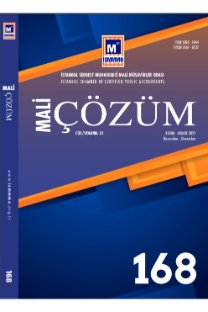Nakit akış tablosunun hazırlanmasında yöntem tartışmaları ve tms 7 standardı şartlarına uygun brüt(dolaysız) yönteme göre örnek bir uygulama
İşletmeler sağlıklı yönetim kararları alabilmek için, doğru ve detaylı nakit akış verilerine ihtiyaç duymaktadır. Bu amaçla düzenlenen nakit akış tabloları, TMS 7nin 18 inci maddesine göre Brüt (Dolaysız) ve Net (Dolaylı) olmak üzere iki yöntemle hazırlanabilmektedir. Standart, işletmeleri yöntem seçme ko- nusunda serbest bırakmıştır. Çalışmada ilgili literatür ışığında, nakit akış tablosu düzenlemede dolaysız yöntemin işletmelere sağlayacağı avantajlar dolaylı yön- tem ile karşılaştırmalı olarak verilmiştir. Dolaysız yöntemle ilgili uygulayıcıların dolaysız yöntem karmaşık ve maliyetli bir yöntemdir algısının değiştirilmesi hedeflenmiştir. Bu amaçla, standart şartlarına uygun, detaylı bir nakit akış tablosu uygulaması yapılmıştır. Tablo kalemlerindeki verilerin nasıl elde edil- diği detaylı bir şekilde açıklanmıştır. Uygulama çalışması, dolaysız yöntem ile hazırlanan nakit akış tablolarının varsayılanın aksine anlaşılır ve sade bir yapıya sahip olduğunu göstermektedir. Ayrıca tablo verilerinin birçoğunun mevcut fi- nansal durum ve gelir tablolarından karşılandığı düşünülürse, veri elde etme ma- liyetlerin de de ekstra bir farklılık olmadığı görülmektedir. Çalışma sonucunda, nakit akış tablosu düzenlemede yaşanan dolaysız-dolaylı yöntem tartışmasında, dolaysız yöntem lehine bir farkındalık yaratılmıştır.
Discussion on methods of issuing cash flow statement, and a sample case according to the gross (direct) method in compliance with tms 7 (Turkish accounting standards) requirements
Enterprises need correct and detailed cash flow data in order to make healthy management decisions. The cash flow statements which are issued for this rea- son can be prepared with two methods as Gross (Direct) and Net (Indirect) according to the article no: 18 of TMS 7. The standard left the enterprises to their own devices on choosing the method. In the study, the advantages of direct method on the enterprise in issuing cash flow statement are given comparatively to the indirect method in the light of the related literature. The aim is to change the perception of users regarding the direct method as direct method is a comp- licated and expensive method. For this purpose, a detailed cash flow statement application was conducted in accordance with the requirements of the standard. How the data in the statement items were obtained was explained in detail. The application study shows that the cash flow statements which were issued with the direct method are clear and simple contrary to the popular belief. In addi- tion, considering that the majority of the statement data is obtained from the existing financial status and income statements, it is observed that there is not any extra difference between the data acquisition costs. At the end of the study, an awareness was raised in favor of the direct method in the direct-indirect discussion on issuing cash flow statement.
___
- Akdoğan, Nalan (2011). Finansal Tablolar ve Mali Analiz Teknikleri. 13. bs. Ankara : Gazi Kitabevi.
- Broome, O. Whitfield (2004). Statement of cash flows: Time for a chan- ge!, Financial Analysts Journal. 8 (March/April 2004): 16 22.
- Bond, D., Bugeva, M. and Czernkowski, R. (2012). Did Australian Firms Choose to Switch to Reporting Operating Cash Flows Using the Indirect Met- hod? Australian Accounting Review. 22;1 (2012) : 18 - 24.
- Bradbury, Michael (2011). Direkt or Indirekt Cash Flow Statement Australian Accounting Review. 21;2 (2011): 124 - 130.
- CFA Institute (2009). Comment Letter on Preliminary Views on FSP. (April 14.) Charlottesville, VA: CFA Institute.
- Chastain, Clark E. and Cianciola, Thomas A. (1986). Strategies In Cash- Flow Management Business Horizons. (May June 1986): 65 73.
- Cheng, Agnes C.S. and Hollie, Dana (2008). Do Core and Noncore Cash Flows from Operations Persist Differentially in Predicting Future Cash Flows Review of Quantitative Finance and Accounting. 31 (2008): 29 53.
- Clinch, G., Sidhu, B., and Sin, S. (2002) The usefulness of direct and indirect cash flow disclosures, Review of Accounting Studies. 7 (2002): 383404.
- Farshadfar, Shadi and Monem, Reza (2013). The usefulness of operating cash flow and accrual components in improving the predictive ability of earnings: a re-examination and extension Accounting & Finance. 53 (2012): 1061 -1082.
- Golub, Steven J. and Huffman, Harry D. (1984). Cash Flow, Why it Should be Stressed in Financial Reporting Financial Executive. 52 (1984): 34 40.
- Habib, Ahsan (2010). Prediction of Operating Cash Flows: Further Evidence from Australia Australian Accounting Review. 20; 2 (2010): 134143.
- Hales, Jeffrey and Orpurt, Steven F. (2013). A Review of Academic Research on the Reporting of Cash Flows from Operations Accounting Hori- zons. 27; 3 (2013): 539 578.
- Türkiye Muhasebe Standartları, TMS 7 Nakit Akış Tabloları Standardı. Ankara : Kamu Gözetimi Muhasebe ve Denetim Standartları Kurumu (KGK), 14.07.2014 tarihinde http://kgk.gov.tr/contents/files/TMS7.pdf adre- sinden erişildi.
- KARKİM A.Ş., Bağımsız Denetim Raporu. 14.07.2014 tarihinde http:// www.karkim.com/files/Bagimsiz_Denetim_Raporu_31_Aralik_2012.pdf ad- resinden erişildi.
- Kısakürek, Mustafa ve Demir, Mehmet (2006). Nakit Akım Tablosunun Hazırlanmasında Direkt - Endirekt Yöntem Tartışması Muhasebe ve Fi- nansman Dergisi. 30 (2006): 201 209.
- Krishnan, Gopal V. and Largay III, James A. (2000). The Predictive Abi- lity of Direct Method Cash Flow Information Journal of Business, Finance & Accounting. 27 (2000): 215 245.
- Opurt, Steven F. and Zang, Yoonseok (2009). Do Direct Cash Flow Disc- losures Help Predict Future Operating Cash Flows and Earnings? The Ac- counting Review. 84;3 (2009): 893 935.
- Nurnberg, Hugo (1993). Inconsistencies And Ambiguties In Cash Flow Statements Under FASB Statement No.95 Accounting Horizons. 7; 2 (1993): 60 75.
- Rue, Joseph,C. and Kirk, Florance (1996). Settling The Cash Flow State- ment Dispute National Public Accountant. 41 (1996): 17 - 24.
- ISSN: 1303-5444
- Yayın Aralığı: Yılda 6 Sayı
- Başlangıç: 1991
- Yayıncı: İstanbul Serbest Muhasebeci Mali Müşavirler Odası
Sayıdaki Diğer Makaleler
Kesinleşmiş sosyal güvenlik prim borçlarının kamu ihalelerine girme yönünden etkisi
Adli muhasebe ve karar alma arasındaki ilişkilerin finansal kararlar açısından değerlendirilmesi
Mesleki gelişmelere sabrımız ve bir arada yaşam
Selim CENGİZ, İsrafil ZOR, Mustafa Ş. DİLSİZ
Vergilerin kanuniliği ilkesi açısından çevre temizlik vergisinde belediye meclislerinin yetkisi
